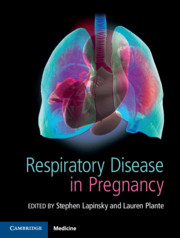Book contents
- Respiratory Disease in Pregnancy
- Respiratory Disease in Pregnancy
- Copyright page
- Contents
- Contributors
- Section 1 The Basics: for the Obstetrician
- Section 2 The Basics: for the Non-Obstetrician
- Section 3 Pulmonary Conditions Not Specific to Pregnancy
- Section 4 Pulmonary Conditions Related to Pregnancy
- Section 5 Other Pulmonary Issues in Pregnancy
- 19 Tobacco Smoking in Pregnancy
- 20 Radiological Imaging of the Chest in Pregnancy
- 21 Respiratory Drug Therapy in Pregnancy
- 22 Biological and Immunosuppressive Respiratory Therapy in Pregnancy
- 23 Oxygen Therapy during Pregnancy
- 24 Airway Management in Pregnancy
- 25 Mechanical Ventilation in Pregnancy
- Index
- References
24 - Airway Management in Pregnancy
from Section 5 - Other Pulmonary Issues in Pregnancy
Published online by Cambridge University Press: 14 April 2020
- Respiratory Disease in Pregnancy
- Respiratory Disease in Pregnancy
- Copyright page
- Contents
- Contributors
- Section 1 The Basics: for the Obstetrician
- Section 2 The Basics: for the Non-Obstetrician
- Section 3 Pulmonary Conditions Not Specific to Pregnancy
- Section 4 Pulmonary Conditions Related to Pregnancy
- Section 5 Other Pulmonary Issues in Pregnancy
- 19 Tobacco Smoking in Pregnancy
- 20 Radiological Imaging of the Chest in Pregnancy
- 21 Respiratory Drug Therapy in Pregnancy
- 22 Biological and Immunosuppressive Respiratory Therapy in Pregnancy
- 23 Oxygen Therapy during Pregnancy
- 24 Airway Management in Pregnancy
- 25 Mechanical Ventilation in Pregnancy
- Index
- References
Summary
Airway management and difficult endotracheal intubation in the pregnant woman require unique considerations that differ from other patient populations. While most pregnant women deliver without the need for airway management, difficulty with endotracheal intubation remains a source of maternal morbidity, maternal mortality and concern for obstetric anaesthesiologists.
- Type
- Chapter
- Information
- Respiratory Disease in Pregnancy , pp. 222 - 232Publisher: Cambridge University PressPrint publication year: 2020



